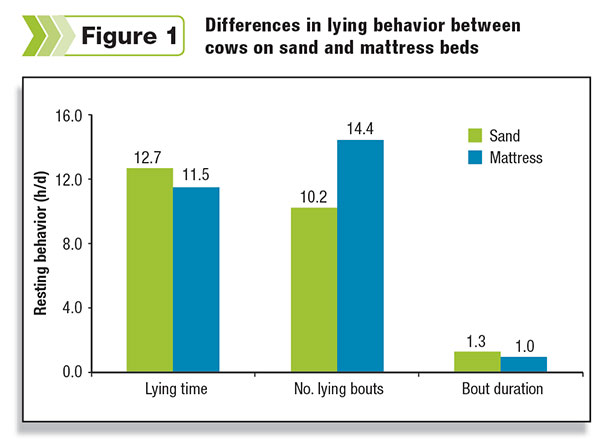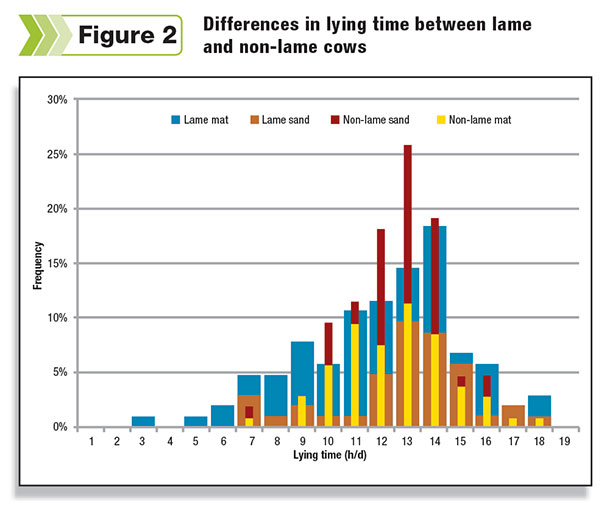This article was #21 of the Top 25 most well-read articles on www.progressivedairy.com in 2014. It was published in the March 12, 2014 print issue. Research from Dr. Nigel Cook and the Food Animal Production Medicine Group at the University of Wisconsin – Madison provides strong support for sand as the top choice for cow comfort and reduced lameness among dairy herds.
Among the key benefits of sand as a bedding source are the traction and support it provides cows, allowing them to get up and down with more ease, particularly older cows. Sand also promotes longer lying bouts and reduces the risk of knee and hock injuries.
:
The topic of sand bedding for dairy cows usually elicits strong reactions from dairy farmers – those who love it or those who hate it. The argument can often be summarized by the statement, “Good for my cows; bad for my manure-handling system.”
It is true to say that managing sand-laden manure is more challenging than manure without sand, but with our current knowledge, we can move the manure out of the barn effectively with flush flumes, vacuum tanks, augers or scraper sleds, and either deal with the settled manure in a concrete-floored manure lagoon or add separation with mechanical or settling lane systems.
Our Food Animal Production Medicine Group at the University of Wisconsin – Madison has been conducting research on stall design for more than a decade now, and through our latest survey conducted by our Dairyland Initiative program, we can provide farmers a strong argument for using sand over other bedding materials.
In 2013, we surveyed 557 freestall-housed dairy herds in the Upper Midwest with 200 cows or more. Sixty-four percent of the herds used sand bedding, suggesting that our producers are listening to us.
When we visited a sample of 66 herds that were among the highest performers, we found a lameness prevalence of 13 percent overall. This average reflected 11 percent prevalence for the sand-bedded herds and 17 percent for the herds using mattresses (primarily rubber crumb-type).
So why is sand so good for dairy cows? We can point to three main benefits from our research:
1. Cows find it easier to get up and down on sand.
If you can take a few minutes, walk out to your barn and watch a few cows rise and lie down in your stalls. Note how the rear feet interact with the surface as the cow rises in the stall. The cushion, traction and support a cow gets on sand bedding are largely absent on flatter, firmer surfaces.
This is tolerated quite well by the younger, non-lame cows, but the older, stiffer cows with sore feet have a significant challenge raising their frame when balancing on the toe of a sore foot. The result: Cows behave differently on mattress stalls than they do on sand.
2. Cows lie down for longer bouts on sand.
A second benefit of the softer, more conforming surface provided by sand is that cows take longer lying bouts (the time from lying down to standing up again in the stall) According to our studies, the difference is about 20 minutes ( Figure 1 ).

We call this the “LaZboy effect.” We can stay in one position longer in a more comfortable chair than on a hard, wooden kitchen seat. The same applies to cows in stalls. Softer surfaces lead to longer lying bouts. So what?
Well, again, for younger and fitter cows, there really isn’t much of a cost associated with lying on a firmer surface for a shorter period of time. Cows are motivated to lie down for about 12 hours a day.
To achieve that goal, they take more, shorter bouts per day. Cows on sand take fewer, longer bouts per day. The problem, again, is the lame or sore-footed older cow.
Asking a lame cow to get up and down more times per day when she is already challenged getting up and down is an obstacle we do not want these animals to have to face. The result is that lame cows struggle to rest normally on firmer bedding surfaces.
In Figure 2 , we see that the distribution of lying times for non-lame cows is relatively normal, with an average of 13 hours a day. However, the distribution of lying time for lame cows is not normal; it is skewed at both ends of the spectrum.

Some lame cows are resting longer than non-lame cows, in some instances up to 18 hours a day. We view these cows as being stuck lying and unable or reluctant to rise. This is bad because these cows do not eat or behave normally.
However, there are also some lame cows that are resting for much shorter periods than non-lame cows, as little as three hours a day. We view these cows as being stuck standing and unable or reluctant to lie down.
This is also bad since these cows spend prolonged periods standing in the stall – loading their sore feet and exacerbating the lameness problem from which they are suffering.
So sand is great because it normalizes resting behavior for lame cows and the impact of this is on the duration of lameness. A study conducted in Finland comparing lame cows on sand bedding versus straw bedding showed that after 21 weeks, the lame cows on sand were recovering, while the cows on straw remained the same.
3. Fewer injuries
There are several other benefits of deep, loose beds of sand: fewer hock and knee injuries, fewer injuries induced by cows getting stuck in stalls, better traction in alleyways and reduced risk for white-line lesions.
Overall, we can quantify a benefit of 7 pounds of energy-corrected milk per cow per day, or just over 2,500 pounds per lactation, for the 117 sand-using dairies in our survey compared to 59 mattress-surface herds. This milk differential will pay for the extra cost of manure handling and lead to improved animal welfare.
Our research also gives us some clues as to how to improve the performance of mattresses. Lameness prevalence in our mattress stall users has been improving over the last 10 years, and mattress manufacturers have been busy improving their products. So for those mattress users wanting to improve lameness, we recommend the following actions:
• Become intolerant of lame cows.
This means aggressively identifying and treating cows as soon as they become lame, which will entail deliberate, weekly surveillance of cows as they enter the holding area by trained individuals capable of locomotion scoring.
• Get the lame cows on a bedded pack.
Move the lame cows off of the mattresses onto a bedded pack where they can recover and rest normally.
• Improve cushion.
For older mattresses, some producers will add more bedding. Manure solids will definitely improve the cushion of the surface but must be managed to reduce the risk of mastitis by frequent removal and replenishment.
Old rubber crumb mattresses can be given a new lease of life by adding 1 to 2 inches of high-memory foam over the rubber crumb cells and replacing the top cover. This will provide more cushion and drive longer lying bouts.
Alternatively, you can invest in a mattress upgrade to one of the newer products that utilize foam or gel to improve cushion not only when the cow is lying down, but also when she is rising and lying. Both are important.
• Routine hoof care
In most herds, we recommend a dry-off trim, a trim in the first 80 to 120 days of lactation and other times when needed. Heifers should be trimmed prior to first calving. Trimming should be performed by a well-trained hoof-trimming professional to avoid injury to cows from too much horn removal. We also recommend frequent footbathing to aid in the control of digital dermatitis and foot rot.
We continue to love sand for our dairy cows. Now we know why. PD

Nigel Cook
Veterinarian
UW–Madison, School of Veterinary Medicine








